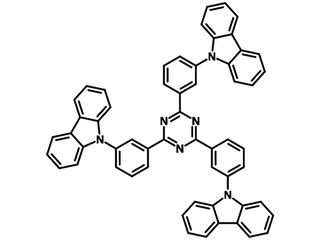TCPZ
CAS Number 890148-68-2
High Purity Sublimed Materials, Host Materials, Materials, OLED Materials, Phosphorescent Host Materials, Semiconducting Molecules,TCPZ, bipolar host to create highly efficient devices with ultra-low driving voltages
For high performance deep-red, green and blue PhOLEDs
TCPZ - 2,4,6-Tris(3-(9H-carbazol-9-yl)phenyl)-1,3,5-triazine is a bipolar host with an electron withdrawn triphenyltriazine center and three electron rich carbazole peripheral units.
With its decreased singlet–triplet exchange energy (ΔEST = 0.24 eV) and low-lying lowest unoccupied molecular orbital (LUMO) energy level, ultra-low driving voltages can be expected by utilizing TCPZ as the host. TCPZ can be used for high performance deep-red, green and blue PhOLEDs for its good bipolar transport feature.
Ir(ppy)3:TCPZ has a lifetime about two times longer than that of the Ir(ppy)3 triplet excitons due to the triplet exciplex formed between Ir(ppy)3 and TCPZ.
General Information
| CAS number | 890148-68-2 |
|---|---|
| Full name | 2,4,6-Tris(3-(9H-carbazol-9-yl)phenyl)-1,3,5-triazine |
| Chemical formula | C57H36N6 |
| Molecular weight | 804.94 g/mol |
| Absorption | λmax 283, 296 nm in film |
| Fluorescence | λmax 467 nm in film |
| HOMO/LUMO | HOMO 6.18 eV, LUMO 2.95 eV[1] |
| Synonyms | 2,4,6-Tris(3-(carbazol-9-yl)phenyl)triazine |
| Classification / Family | Triazine derivatives, Bipolar host materials, PHOLEDs host materials, Sublimed materials. |
Product Details
| Purity | Sublimed >99.0% (HPLC) |
|---|---|
| Melting point | Tg = 162 ℃ |
| Appearance | Yellow powder/crystals |
*Sublimation is a technique used to obtain ultra pure-grade chemicals. For more details about sublimation, please refer to the Sublimed Materials.
Chemical Structure
MSDS Documentation
Literature and Reviews
- A host material with a small singlet–triplet exchange energy for phosphorescent organic light-emitting diodes: Guest, host, and exciplex emission, S. Su et al., Org. Electron. 13 (10); 1937-1947 (2012); DOI: 10.1016/j.orgel.2012.06.009.
- A Bipolar and Small Singlet-Triplet Splitting Energy Host with Triplet Energy Lower Than a Blue Phosphor for Phosphorescent OLEDs in Panchromatic Range, Chin. J. Chem., 34 (8), 763-770 (2016); C. Wang et al., DOI: 10.1002/cjoc.201600147.
- Extremely low driving voltage electrophosphorescent green organic light-emitting diodes based on a host material with small singlet–triplet exchange energy without p- or n-doping layer, D. Zhang et al., Org. Electron. 14 (1); 260-266 (2013); DOI: 10.1016/j.orgel.2012.11.003.

